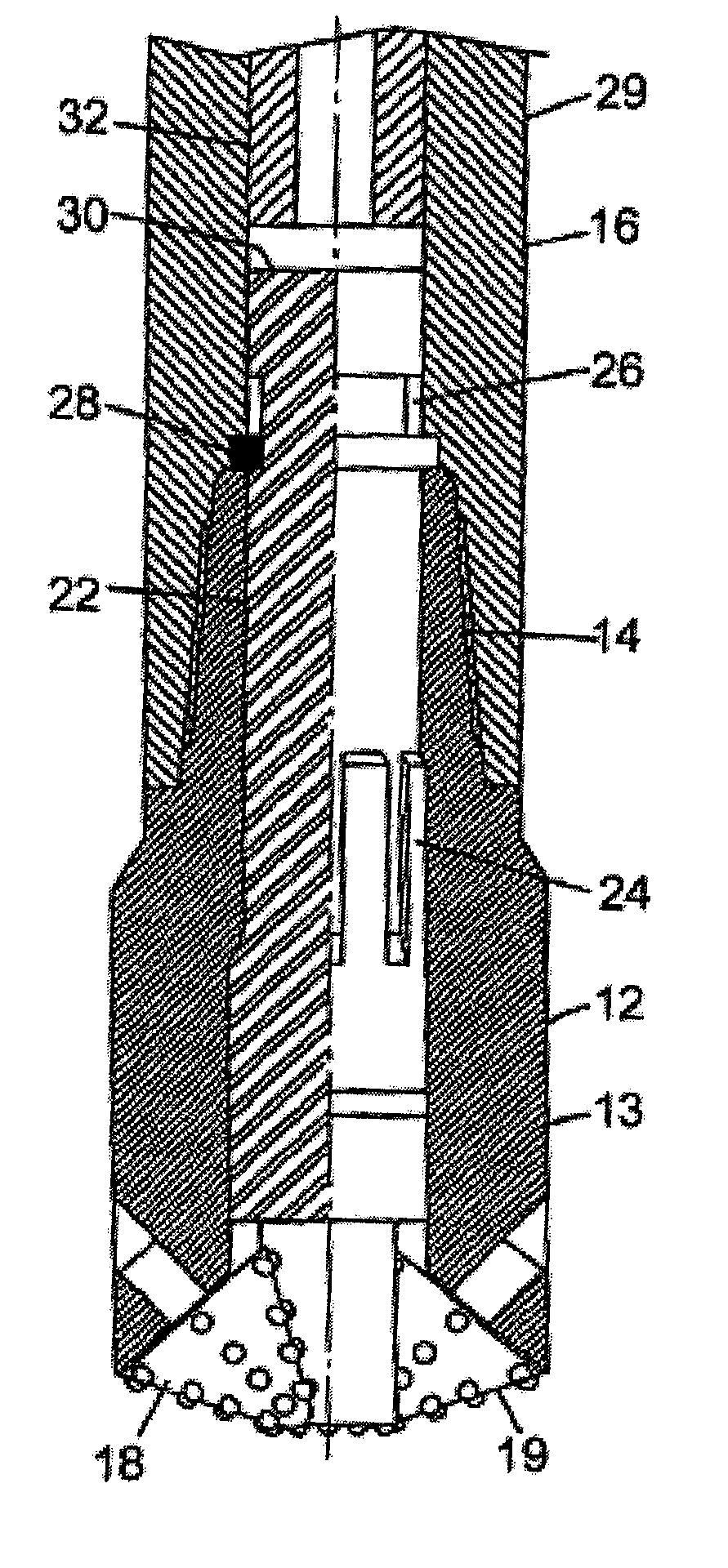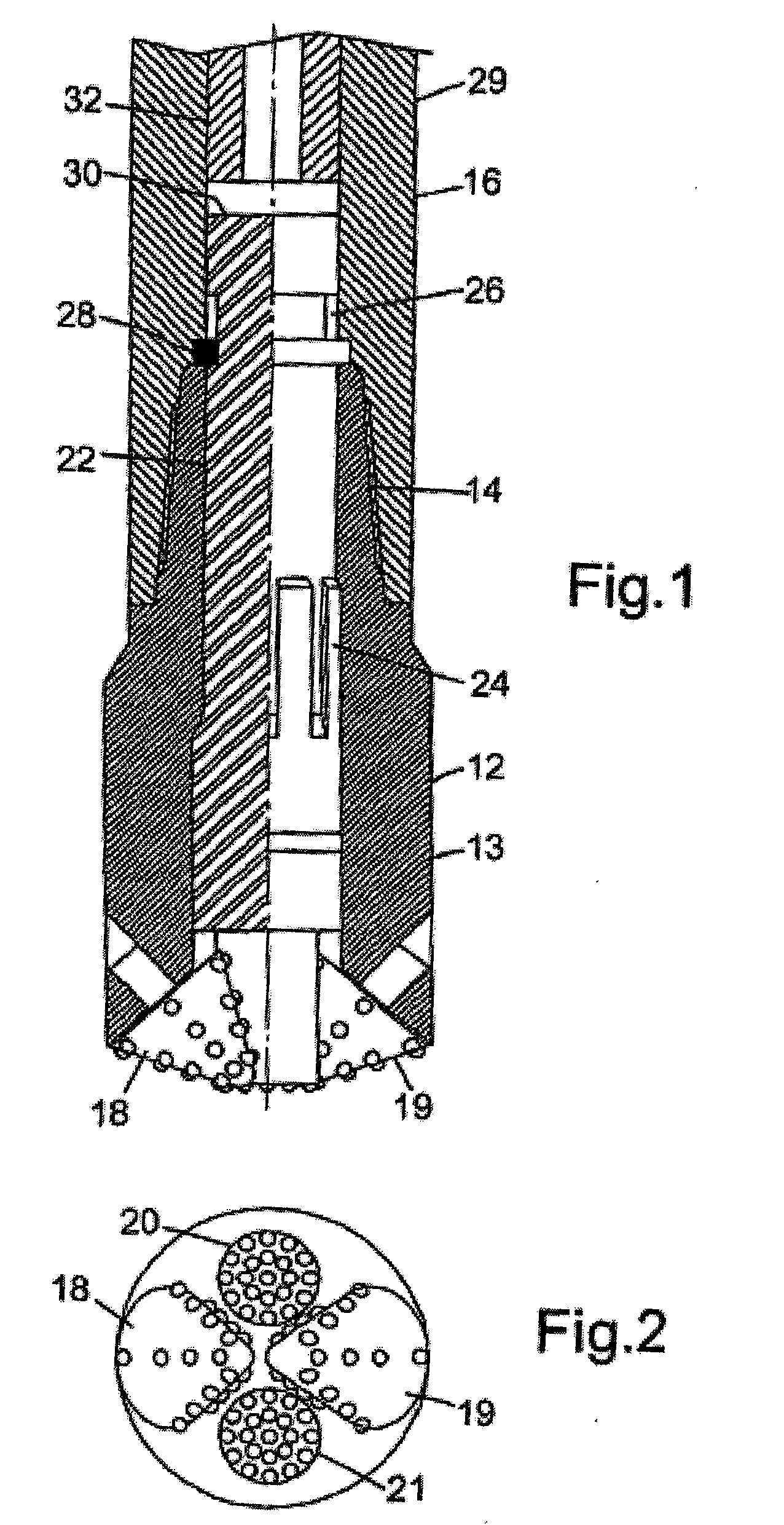Drilling apparatus with percussive action cutter
a technology of percussive action and drilling equipment, which is applied in drilling drives, drilling drives, and surveying, etc., can solve the problems of limiting the cutting effectiveness of the bit, and achieve the effect of facilitating a greater degree of control
- Summary
- Abstract
- Description
- Claims
- Application Information
AI Technical Summary
Benefits of technology
Problems solved by technology
Method used
Image
Examples
first embodiment
[0031] Reference is first made to FIGS. 1, 2 and 3 of the drawings, which show a drilling apparatus 10 in accordance with the present invention. The apparatus 10 comprises a bit 12 mounted via a pin and box connection 14 to the lower end of a hammer tool 16.
[0032] Mounted on the lower end of the drill bit are two roller cones 18, 19; when the bit 12 is rotated, the cones 18, 19 will roll over the rock formation below the bit 12, crushing or otherwise dislodging cuttings from the rock. The cutting structure of the bit 12 is further defined by two circular cutting faces defined by the ends of a pair of percussive action cutters 20, 21. As may be seen from FIG. 2, the roller cones 18, 19 are positioned on opposite sides of the bit 12, and the percussive action cutters 20, 21 are located in the quadrants between the roller cones 18, 19.
[0033] Both percussive action cutters 20, 21 are mounted on the end of a mandrel 22 which extends through the bit body and into the hammer tool 16. The ...
second embodiment
[0037] Reference is now made to FIGS. 4 and 5 of the drawings, which illustrates drilling apparatus 40 in accordance with the invention. The apparatus 40 shares a number of features with the apparatus 10 described above, however in this apparatus 40 only a single percussive action cutter 42 is provided, and the cutter 42 is located centrally of the drill bit 43. Thus, in the course of a drilling operation, the percussive action cutter 42 will cut a pilot bore, and the following roller cone cutters 44, 45 will effectively provide a reaming operation to bring the bore out to gauge.
[0038] The cutter 42 is mounted on the lower end of a mandrel 46, the upper end of which defines an anvil 48 which is struck by the hammer 50 of the percussive tool 52 provided above the apparatus 40. The tool body 54 defines a bore 56 and the anvil 48 features a seal 58 which provides a sliding seal between the bore 56 and the anvil 48; as with the previous embodiment, the “weight” or force normally applied...
third embodiment
[0044] Reference is now made to FIG. 6 of the drawings, which illustrates, in section, a view of a part of a drilling apparatus 70 in accordance with the present invention. The apparatus 70 shares many features with the apparatus 40 described above, and additionally includes a spring 72 provided between a shoulder on the anvil 74 and the ring 76 trapped between the lower end of the hammer tool body 78 and the upper end of the bit body 80. The spring 72 is selected such that the percussive action cutter 82 is normally held slightly off bottom 84, as illustrated. The cutter 82 thus only contacts the bore bottom 84 when the hammer 86 strikes the anvil 74 and drives the bit ahead such that the cutter 82 impacts the formation. The cutter 82 is thus touching the bottom of the hole only for the duration of the hammer blow, and when the hammer 86 moves away from the anvil 74 the cutter 82 springs back off the bottom of the hole.
[0045] This feature of the apparatus 70 reduces the rubbing act...
PUM
 Login to View More
Login to View More Abstract
Description
Claims
Application Information
 Login to View More
Login to View More - R&D
- Intellectual Property
- Life Sciences
- Materials
- Tech Scout
- Unparalleled Data Quality
- Higher Quality Content
- 60% Fewer Hallucinations
Browse by: Latest US Patents, China's latest patents, Technical Efficacy Thesaurus, Application Domain, Technology Topic, Popular Technical Reports.
© 2025 PatSnap. All rights reserved.Legal|Privacy policy|Modern Slavery Act Transparency Statement|Sitemap|About US| Contact US: help@patsnap.com



